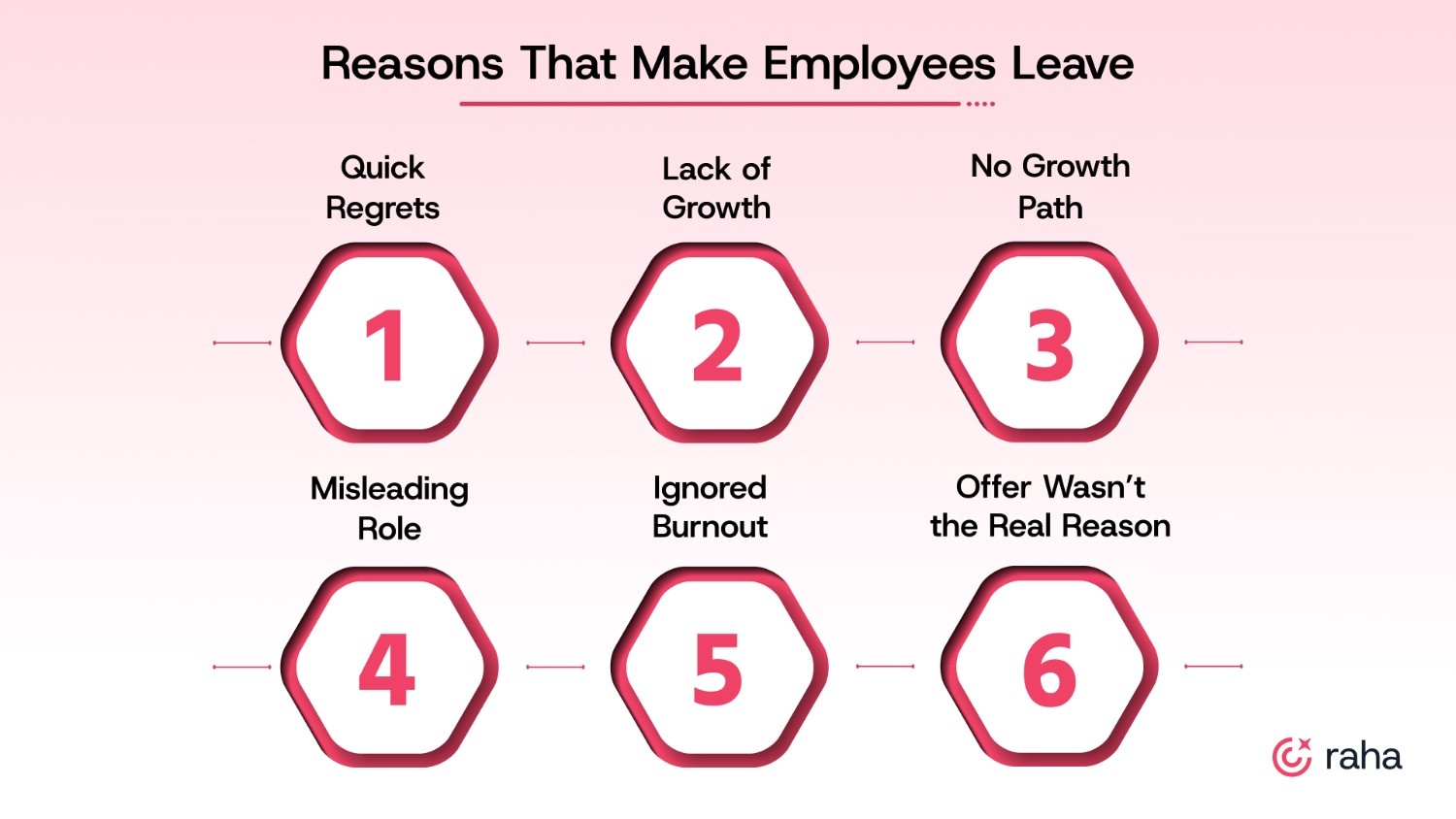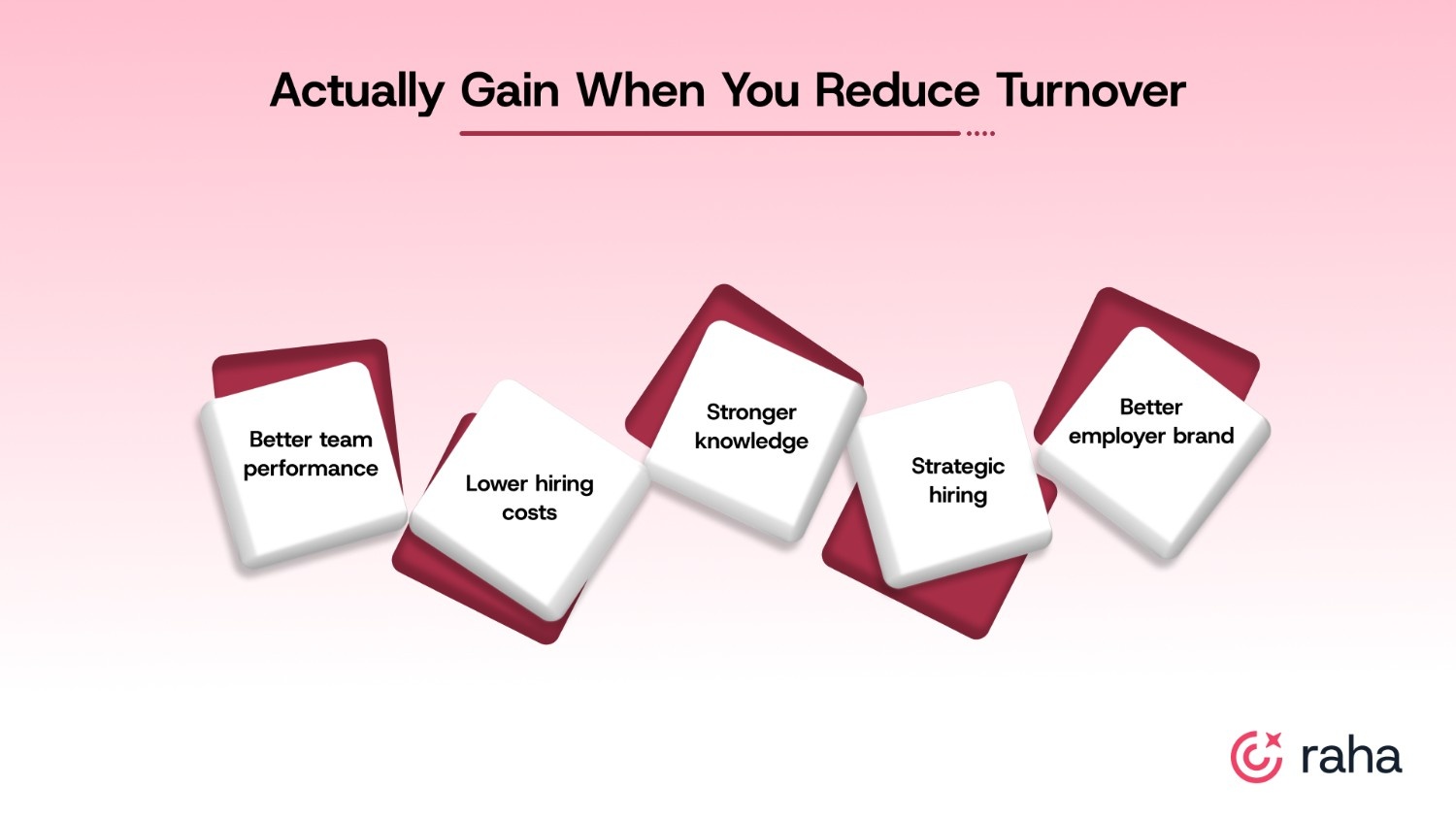
A great new hire quits after 30 days. Your sales pipeline slows because you're short-staffed again. Your best engineer accepts a counteroffer because no one saw it coming.
They feel like isolated events—until they start piling up and hitting your bottom line.
The average U.S. monthly turnover rate has settled from 17.3% in 2023 to 3.3% in 2025 — but that stat means little without context. In retail and wholesale, it’s closer to 25%. In healthcare, burnout is pushing even tenured teams to leave. In tech, the moment a role feels misaligned, candidates are gone.
What looks like a people problem is often a process issue in disguise. And by the time you're reacting to it, the damage is already done.
In this blog, we’ll break down 2025 turnover rates by industry, unpack the real reasons employees leave, and show you how to reduce attrition before it becomes a pattern.
Key Takeaways:
- Employee turnover is often a symptom of deeper process issues like misaligned expectations, weak onboarding, or a lack of growth opportunities.
- Industry benchmarks vary widely, so turnover rates must be analyzed in the right context to understand if there's a real problem.
- Retention isn't just about keeping people. It's about keeping the right people engaged, productive, and aligned with business goals.
- Reducing turnover leads to stronger team performance, lower hiring costs, better knowledge retention, and more strategic recruiting.
What is an Employee Turnover Rate?
At its simplest, the employee turnover rate is the percentage of employees who leave your company over a specific time period. But for teams that care about long-term retention, performance, and cost, it’s more than a stat—it’s a warning flag.
When tracked properly, the turnover rate reveals what’s breaking downstream:
- Are new hires leaving before ramping?
- Are certain departments or levels burning out?
- Are expectations misaligned between hiring and reality?
To calculate it, use this formula:
Turnover Rate = (Employees who left ÷ Average headcount) × 100
So, let’s say you had 15 people leave last quarter, and your average team size was 120. Your turnover rate is 12.5%.
But the number alone doesn’t mean much until you dig deeper. You need to check:
- Was that attrition voluntary or involuntary?
- Was it new hires or tenured team members?
- Did they leave for a better offer, a broken process, or unclear growth?
As of May 2025, the average monthly turnover rate across all U.S. industries is 3.3%, according to the U.S. Bureau of Labor Statistics (BLS).
So if your rate is double that, the issue likely goes deeper than comp. You’re looking at structural problems such as weak onboarding, unclear role expectations, or poor manager fit.
Employee Turnover Rate vs. Retention Rate
Teams often confuse these two metrics or treat them like interchangeable signals. They’re not. And lumping them together hides the real issue.
Tracking both gives you a clearer signal. A 90% retention rate might look fine until you realize most of the attrition happened in the first 60 days. That’s not a retention win. That’s a hiring or onboarding miss.
What is the Average Employee Turnover Rate by Industry?
Not all turnover is created equal. A 2.5% exit rate might be alarming for one industry and totally normal for another. That’s why benchmarking matters. It gives your numbers the right context.
Here’s what turnover typically looks like across major U.S. industries in 2025:
Source: U.S. Bureau of Labor Statistics (BLS), May 2025
Turnover rates vary by industry, but the reasons people leave often sound the same. It’s not always about pay — it’s mismatched expectations, poor management, lack of growth, or just a broken day-to-day. Before you fix the number, you need to understand what’s behind it.

What Are the Common Reasons That Make Employees Leave?
If you’re seeing attrition, don’t just look at exit interviews. Look at the moments where the employee experience started breaking down.
Here are the most common reasons employees leave and what experienced teams do to prevent them.

1. They Regret Joining Within Weeks
When onboarding is unstructured, confusing, or overly administrative, new hires are more likely to second-guess their decision to join. Without clear expectations, consistent manager check-ins, and a sense of belonging, they tend to disengage quickly.
What you can do:
Create a structured 30-60-90 day plan that includes role-specific goals, regular meetings with the manager, and a support system. Onboarding should give clarity and confidence, not leave new hires guessing.
Result:
- Reduces new hire turnover (track: 30-, 60-, 90-day attrition)
- Improves onboarding satisfaction and time-to-productivity
- Boosts employee engagement and manager trust scores
- Reduces regrettable attrition on high-performing teams
2. Their Manager Isn’t Helping Them Grow
Even in a strong company, one ineffective manager can drive good people out. If employees feel unsupported, micromanaged, or unsure about their standing, they begin looking elsewhere.
What you can do:
Invest in real training for managers. Focus on communication, feedback, and building trust. Use pulse surveys and skip-level check-ins to catch early signs of friction.
Result:
- Boosts employee engagement and manager trust scores
- Reduces regrettable attrition on high-performing teams
3. There’s No Real Path Forward
When employees can’t see a future with the company, they assume they need to leave to move forward. Career stagnation is one of the most consistent drivers of attrition, especially in high-growth industries.
What you can do:
Make growth paths visible and actionable. Use career frameworks, regular development check-ins, and give stretch opportunities even before promotions are available.
Result:
- Increases internal mobility and retention
- Improves long-term employee lifetime value (ELTV)
4. The Role Didn’t Match the Pitch
When the day-to-day job doesn’t match what was promised during hiring, trust breaks quickly. Employees notice when flexibility, collaboration, or culture feel like empty words.
What you can do:
Review your candidate messaging and hiring pitch. Ensure that what you communicate externally aligns with what employees actually experience. If there’s a gap, address it early and honestly.
Result:
- Reduces early attrition due to expectation mismatch
- Improves offer-to-start conversion and ratings
Where Raha AI helps:
Role mismatches often stem from vague job descriptions and inconsistent screening conversations. Raha AI helps you align expectations right from the start. Here’s how:
- AI Resume Screener: Automatically pulls structured candidate data from resumes, scores for fit, and flags profiles that align with the JD, so your shortlists reflect the actual role.
- AI Interviewer: Runs the first screening call with each candidate, asks JD-specific questions, and returns a full report, ensuring every candidate hears the same pitch and expectations stay aligned.
5. They’re Burned Out and No One Notices
Burnout builds gradually. It can come from constant meetings, unclear priorities, or always-on expectations. Even if productivity seems stable, people may already be planning their exit.
What you can do:
Track workload and capacity regularly. Normalize time off and clarify expectations around working hours and responsiveness. If certain teams are stretched thin, fix the resourcing before you lose top performers.
Result:
- Improves engagement and reduces burnout-related turnover
- Boosts productivity and employee well-being scores
6. The Offer Wasn’t the Real Reason
Sometimes a better offer is the final push, but usually the decision to leave began internally. Something made the employee open to looking elsewhere.
What you can do:
Don’t wait for exit interviews. Use stay interviews to understand what would make high performers leave. Keep compensation, flexibility, and growth aligned with what your team values today, not just what worked last year.
Result:
- Increases retention of top performers
- Reduces mid-tenure attrition and prevents offer-stage drop-offs

What You Actually Gain When You Reduce Turnover
Reducing turnover unlocks a more stable, productive, and cost-effective business. When the right people stay longer, everything gets easier—from project delivery to recruiting strategy.
Here’s what starts to shift in your favor:

- Better team performance: Stable teams collaborate better, move faster, and deliver more consistent results. You’re not constantly restarting projects or re-teaching processes.
- Lower hiring costs: Fewer backfills mean less spent on job boards, sourcing tools, recruiter hours, and onboarding. The budget can shift toward growth instead of replacement.
- Stronger institutional knowledge: Longer tenures mean deeper understanding of your systems, customers, and business goals. That knowledge compounds, instead of walking out the door.
- More strategic hiring: With fewer urgent roles to refill, TA teams can spend more time on proactive pipeline building and high-impact roles.
- Better employer brand: When employees stay and share positive experiences, it sends a strong signal to future candidates. That credibility improves offer acceptance and candidate quality.
Also read: How to Build an Employer Branding Strategy
Hire Right with Raha AI and Stop Turnover Before It Starts
The biggest drivers of attrition are almost always rooted in mismatched expectations, weak onboarding, or poor role fit. Fix those early, and you prevent the churn later.
That’s where Raha AI helps.
We help recruiting teams build stronger hiring foundations by automating the most critical and often most error-prone parts of the process:
- Screen smarter with AI-powered resume review and fit scoring.
- Run consistent, role-specific first-round interviews.
- Coordinate interviews automatically without back-and-forths.
Book your demo today and start closing hires that stick.
FAQs
1. How can I calculate the employee turnover rate?
Employee turnover rate is calculated by dividing the number of employees who left during a specific period by the average number of employees during that period, then multiplying by 100. This helps you measure the percentage of employees who didn’t stick around.
2. What is a good employee retention rate?
A high retention rate (above 80%) typically signals that employees are happy, engaged, and satisfied with their roles. Low retention rates, however, indicate that there may be problems with company culture, career development, or management.
3. Why is the turnover rate so high in the retail and wholesale industries?
The retail and wholesale industries often face high turnover due to low wages, limited career progression, and seasonal employment. High-stress environments and customer-facing roles also contribute to burnout.
4. How can tech companies reduce employee turnover?
Tech companies can improve retention by maintaining regular leadership communication, using pulse surveys to gauge morale, investing in digital tools for hybrid teams, and creating a strong recognition program to keep employees engaged.
5. What role does compensation play in reducing turnover?
Adequate compensation and benefits are crucial for retention. If employees feel underpaid for their work, they are more likely to seek opportunities elsewhere. Regularly reviewing pay scales and offering competitive benefits can significantly reduce turnover.

